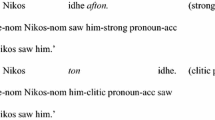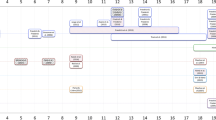Abstract
Five areas of research concerned with language acquisition— cognitive processes, semantics, pragmatics, phonology, and syntax— are reviewed in terms of their contribution to understanding language disorders. Two views of cognitive processes are discussed. One of these, emphasizing cognitive mechanisms such as short-term memory, is seen as providing possible explanations for some types of language deficits. The other, a concern with conceptual knowledge, is subjected to a critical analysis questioning how complete an explanation it is able to offer for some aspects of language acquisition. Problems of definition are also discussed when semantic aspects of language are considered. Problems in the pragmatic component of language are seen as providing an explanation for particular aspects of language disorder in some autistic children. The importance of focusing on phonology as a central grammatical process is discussed and linked to dyslexia and to spelling disorders. Finally, it is argued that the acquisition of syntactic structure is not yet understood. Impairments such as a hierarchical planning order deficit may affect syntactic ability and lead to disordered language, as found in some types of developmentally aphasic children. It is concluded that it is important to study all five areas of the title, and their interrelationships, if various language disorders are to be adequately understood.
Similar content being viewed by others
References notes
McCawley, J. D.A review of Noam A. Chomsky, “Studies on semantics in generative grammar.” Paper reproduced by the Indiana University Linguistics Club, Bloomington, Indiana, 1973.
Curtiss, S., Fromkin, V., & Yamada, J. E.The independence of language as a cognitive system. Paper presented at the First International Congress for the Study of Child Language, Tokyo, August 7–12, 1978.
Slobin, D. I.Universal and particular in the acquisition of language. Paper presented at the workshop-conference, “Language Acquisition: State of the Art,” University of Pennsylvania, May 19–22, 1978.
Geller, E, F., & Wollner, S. G.A preliminary investigation of the communicative competence of three linguistically impaired children. Paper presented at the New York State Speech and Hearing Association, Grossingers, New York, 1976.
Bever, T. G. Personal communication, 1979.
Lea, J.An investigation into the association between rhythmic ability and language ability in a group of children with severe speech and language disorders. Unpublished master's thesis, University of London, Guy's Hospital Medical School, 1975.
References
Aurnhammer-Frith, U. Emphasis and meaning in recall in normal and autistic children.Language and Speech, 1969,12, 29–38.
Baltaxe, C. A. M. Pragmatic deficits in the language of autistic adolescents.Journal of Pediatric Psychology, 1977,2, 176–180.
Baltaxe, C., & Simmons, J. Q., III. Language patterns of adolescent autistics: A comparison between English and German. In P. Mittler (Ed.),Research to practice in mental retardation, Volume II: Education and training. Baltimore: University Park Press, 1977. Pp. 267–278.
Bartlett, E. J. The acquisition of the meaning of color terms: A study of lexical development. In R. N. Campbell & P. T. Smith (Eds.),Recent advances in the psychology of language: Language development and mother-child interaction. New York: Plenum Press, 1978. Pp. 89–108.
Bates, E.Language and context: The acquisition of pragmatics. New York: Academic Press, 1976.
Bellugi, U.The acquisition of the system of negation in children's speech. Unpublished doctoral dissertation, Harvard University, 1967.
Bellugi, U. Simplification in children's language. In R. Huxley & E. Ingram (Eds.),Language acquisition: Models and methods. London and New York: Academic Press, 1971. Pp. 95–119.
Bever, T. G. The cognitive basis for linguistic structures. In J. R. Hayes (Ed.),Cognition and the development of language. New York: Wiley, 1970. Pp. 279–362.
Blank, M., Gessner, M., & Esposito, A. Language without communication: A case study.Journal of Child Language, 1979,6, 329–352.
Bloom, L.Language development: Form and function in emerging grammars. Cambridge: M.I.T. Press, 1970.
Brown, R.A first language. Cambridge: Harvard University Press, 1973.
Carey, S. The child as word learner. In M. Halle, J. Bresnan, & G. A. Miller (Eds.),Linguistic theory and psychological reality. Cambridge: M.I.T. Press, 1978. Pp. 264–293.
Chomsky, N.Aspects of the theory of syntax. Cambridge: M.I.T. Press, 1965.
Chomsky, N.Cartesian linguistics. New York: Harper & Row, 1966.
Chomsky, N.Language and mind. New York: Harcourt Brace Jovanovich, 1968.
Conrad, R. The developmental role of vocalizing in short-term memory.Journal of Verbal Learning and Verbal Behavior, 1972,11, 521–533.
Cromer, R. F.The development of temporal reference during the acquisition of language. Unpublished doctoral dissertation, Harvard University, 1968.
Cromer, R. F. The development of language and cognition: The cognition hypothesis. In B. Foss (Ed.),New perspectives in child development. Harmondsworth, Middlesex: Penguin Books, 1974. Pp. 184–252.
Cromer, R. F. The basis of childhood dysphasia: A linguistic approach. In M.A. Wyke (Ed.),Developmental dysphasia. London & New York: Academic Press, 1978. Pp. 85–134. (a)
Cromer, R. F. Hierarchical disability in the syntax of aphasic children.International Journal of Behavioral Development, 1978,1, 391–402. (b)
Cromer, R. F. Empirical evidence in support on non-empiricist theories of mind.Behavioral and Brain Sciences, 1980,5, 16–18. (a)
Cromer, R. F. Normal language development: Recent progress. In L. A. Hersov, M. Berger, & A. R. Nicol (Eds.),Language and language disorders in childhood. Oxford: Pergamon Press, 1980. Pp. 1–21. (b).
Cromer, R. F. Hierarchical ordering disability and aphasic children. In P. S. Dale & D. Ingram (Eds.),Child language: An international perspective. Baltimore: University Park Press, 1981. (a)
Cromer, R. F. Reconceptualizing language acquisition and cognitive development. In R. L. Schiefelbusch & D. Bricker (Eds.),Early language Acquisition and intervention. Baltimore: University Park Press, 1981. Pp. 51–137. (b)
Dodd, B. A comparison of the phonological systems of mental age matched normals, severely subnormals, and Down's syndrome children.British Journal of Disorders of Communication, 1976,11, 27–42.
Ferguson, C. A., & Farwell, C. B. Words and sounds in early language acquisition.Language, 1975,57, 419–439.
Fillmore, C. J. The case for case. In E. Bach & R. T. Harms (Eds.),Universals in linguistic theory. New York: Holt, Rinehart & Winston, 1968. Pp. 1–88.
Fodor, J. A.The language of thought. New York: Crowell, 1975.
Frith, U. (Ed.).Cognitive processes in spelling. London & New York: Academic Press, 1980.
Geschwind, N. The varieties of naming errors.Cortex, 1967,3, 97–112.
Goodson, B. D., & Greenfield, P. M. The search for structural principles in children's manipulative play: A parallel with linguistic development.Child Development, 1975,46, 734–746.
Graham, N. C. Short term memory and syntactic structure in educationally subnormal children.Language and Speech, 1968,11, 209–219.
Graham, N. C. Response strategies in the partial comprehension of sentences.Language and Speech, 1974,17, 205–221.
Graham, N. C., & Gulliford, R. A. A psychological approach to the language deficiencies of educationally subnormal children.Educational Review, 1968,20, 136–145.
Greenfield, P. M. Structural parallels between language and action in development. In A. Lock (Ed.),Action, gesture and symbol: The emergence of language. London & New York: Academic Press, 1978. Pp. 415–445.
Greenfield, P. M., Nelson, K., & Saltzman, E. The development of rulebound strategies for manipulating seriated cups: A parallel between action and grammar.Cognitive Psychology, 1972,5, 291–310.
Greenfield, P. M., & Schneider, L. Building a tree structure: The development of hierarchical complexity and interrupted strategies in children's construction activity.Developmental Psychology, 1977,13, 299–313.
Ingram, D. Phonological patterns in the speech of young children. In P. Fletcher & M. Garman (Eds.),Language acquisition: Studies in first language development. Cambridge: Cambridge University Press, 1979. Pp. 133–148.
Keenan, E. L., & Comrie, B. Noun phrase accessibility and universal grammar.Linguistic Inquiry, 1917,8, 63–99.
Kracke, I. Perception of rhythmic sequences by receptive aphasic and deaf children.British Journal of Disorders of Communication, 1975,10, 43–51.
Lakoff, G. Presupposition and relative well-formedness. In D. D. Steinberg & L. A. Jakobovits (Eds.),Semantics. Cambridge: Cambridge University Press, 1971. Pp. 329–340.
Landau, W. M., & Kleffner, F. R. Syndrome of acquired aphasia with convulsive disorder in children.Neurology, 1957,7, 523–530.
Leonard, L. B., Newhoff, M., & Mesalam, L. Individual differences in early child phonology.Applied Psycholinguistics, 1980,1, 7–30.
Lyons, J.Semantics (Vols. 1 & 2). London: Cambridge University Press, 1977.
Martin, J. G. Rhythmic (hierarchical) versus serial structure in speech and other behavior.Psychological Review, 1972,79, 487–509.
McCawley, J. D. Meaning and the description of languages. In J. F. Rosenberg & C. Travis (Eds.),Readings in the philosophy of language. Englewood Cliffs, New Jersey: Prentice-Hall, 1971. Pp. 533–548. (a)
McCawley, J. D. Where do noun phrases come from? In D. D. Steinberg & L. A. Jakobovits (Eds.),Semantics. Cambridge: Cambridge University Press, 1971. Pp. 217–231. (b)
McKinney, W., & McGreal, D. A. An aphasic syndrome in children.Canadian Medical Association Journal, 1974,110, 637–639.
Menyuk, P. Comparison of grammar of children with functionally deviant and normal speech.Journal of Speech and Hearing Research, 1964,7, 109–121.
Menyuk, P.Sentences children use. Cambridge: M.I.T. Press, 1969.
Menyuk, P., & Menn, L. Early strategies for the perception and production of words and sounds. In P. Fletcher & M. Garman (Eds.),Language acquisition: Studies in first language development. Cambridge: Cambridge University Press, 1979. Pp. 49–70.
Miller, G. A. Semantic relations among words. In M. Halle, J. Bresnan, & G. A. Miller (Eds.),Linguistic theory and psychological reality. Cambridge: M.I.T. Press, 1978. Pp. 60–118.
Miller, G. A., & Johnson-Laird, P. N.Language and perception. Cambridge: Cambridge University Press, 1976.
Miller, G. A., & Miller, K. John Lyons on semantics.Quarterly Journal of Experimental Psychology, 1979,31, 711–735.
O'Connor, N., & Frith, U. Cognitive development and the concept of set. In A. Prangishvili (Ed.),Psychological investigations: A commemorative volume dedicated to the 85th Anniversary of the birth of D. Uznadze. Tbilisi, USSR: Metsniereba, 1973. Pp. 296–300.
Piaget, J., & Inhelder, B. The gaps in empiricism. In A. Koestler & J. R. Smythies (Eds.),Beyond reductionism. London: Hutchinson, 1969. Pp. 118–160.
Rapin, I., & Wilson, B. C. Children with developmental language disability: Neurological aspects and assessment. In M. A. Wyke (Ed.),Developmental dysphasia. London & New York: Academic Press, 1978. Pp. 13–41.
Rees, N. S. Pragmatics of language: Applications to normal and disordered language development. In R. L. Schiefelbusch (Ed.),Bases of language intervention. Baltimore: University Park Press, 1978. Pp. 191–268.
Rosch, E. Linguistic relativity. In P. N. Johnson-Laird & P. C. Wason (Eds.),Thinking: Readings in cognitive science. Cambridge: Cambridge University Press, 1977. Pp. 501–519.
Schlesinger, I. M.Production and comprehension of utterances. Hillsdale, New Jersey: Earlbaum, 1977.
Slobin, D. I. The acquisition of Russian as a native language. In F. Smith & G. A. Miller (Eds.),The genesis of language. Cambridge: M.I.T. Press, 1966. Pp. 129–148.
Snowling, M. J. The development of grapheme-phoneme correspondence in normal and dyslexic readers.Journal of Experimental Child Psychology, 1980,29, 294–305.
Snyder, L. S.Pragmatics in language disabled children: Their prelinguistics and early verbal performatives and presuppositions. Unpublished doctoral dissertation, University of Colorado, Denver, 1975.
Van Harskamp, F., Van Dongen, H. R., & Loonen, M. C. B. Acquired aphasia with convulsive disorders in children: A case with a seven-year follow-up.Brain and Language, 1978,6, 141–148.
Vygotsky, L. S.Thought and language. Cambridge: M.I.T. Press; New York: Wiley, 1962. (Originally published, 1934).
Warrington, E. K., Logue, V., & Pratt, R. T. C. The anatomical localization of selective impairment of auditory verbal short-term memory.Neuropsychologia, 1971,9, 377–387.
Worster-Drought, C. An unusual form of acquired aphasia in children.Developmental Medicine and Child Neurology, 1971,13, 563–571.
Author information
Authors and Affiliations
Rights and permissions
About this article
Cite this article
Cromer, R.F. Developmental language disorders: Cognitive processes, semantics, pragmatics, phonology, and syntax. J Autism Dev Disord 11, 57–74 (1981). https://doi.org/10.1007/BF01531341
Issue Date:
DOI: https://doi.org/10.1007/BF01531341




